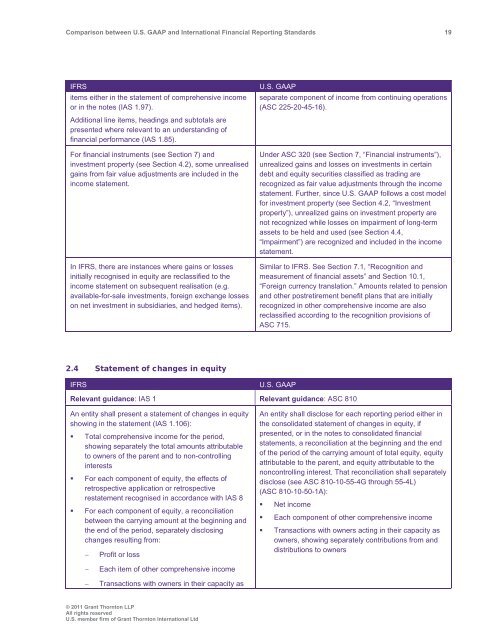Comparison between U.S. GAAP and International ... - Grant Thornton
Comparison between U.S. GAAP and International ... - Grant Thornton
Comparison between U.S. GAAP and International ... - Grant Thornton
Create successful ePaper yourself
Turn your PDF publications into a flip-book with our unique Google optimized e-Paper software.
<strong>Comparison</strong> <strong>between</strong> U.S. <strong>GAAP</strong> <strong>and</strong> <strong>International</strong> Financial Reporting St<strong>and</strong>ards 19<br />
IFRS<br />
items either in the statement of comprehensive income<br />
or in the notes (IAS 1.97).<br />
Additional line items, headings <strong>and</strong> subtotals are<br />
presented where relevant to an underst<strong>and</strong>ing of<br />
financial performance (IAS 1.85).<br />
For financial instruments (see Section 7) <strong>and</strong><br />
investment property (see Section 4.2), some unrealised<br />
gains from fair value adjustments are included in the<br />
income statement.<br />
In IFRS, there are instances where gains or losses<br />
initially recognised in equity are reclassified to the<br />
income statement on subsequent realisation (e.g.<br />
available-for-sale investments, foreign exchange losses<br />
on net investment in subsidiaries, <strong>and</strong> hedged items).<br />
U.S. <strong>GAAP</strong><br />
separate component of income from continuing operations<br />
(ASC 225-20-45-16).<br />
Under ASC 320 (see Section 7, “Financial instruments”),<br />
unrealized gains <strong>and</strong> losses on investments in certain<br />
debt <strong>and</strong> equity securities classified as trading are<br />
recognized as fair value adjustments through the income<br />
statement. Further, since U.S. <strong>GAAP</strong> follows a cost model<br />
for investment property (see Section 4.2, “Investment<br />
property”), unrealized gains on investment property are<br />
not recognized while losses on impairment of long-term<br />
assets to be held <strong>and</strong> used (see Section 4.4,<br />
“Impairment”) are recognized <strong>and</strong> included in the income<br />
statement.<br />
Similar to IFRS. See Section 7.1, “Recognition <strong>and</strong><br />
measurement of financial assets” <strong>and</strong> Section 10.1,<br />
“Foreign currency translation.” Amounts related to pension<br />
<strong>and</strong> other postretirement benefit plans that are initially<br />
recognized in other comprehensive income are also<br />
reclassified according to the recognition provisions of<br />
ASC 715.<br />
2.4 Statement of changes in equity<br />
IFRS<br />
U.S. <strong>GAAP</strong><br />
Relevant guidance: IAS 1 Relevant guidance: ASC 810<br />
An entity shall present a statement of changes in equity<br />
showing in the statement (IAS 1.106):<br />
• Total comprehensive income for the period,<br />
showing separately the total amounts attributable<br />
to owners of the parent <strong>and</strong> to non-controlling<br />
interests<br />
• For each component of equity, the effects of<br />
retrospective application or retrospective<br />
restatement recognised in accordance with IAS 8<br />
• For each component of equity, a reconciliation<br />
<strong>between</strong> the carrying amount at the beginning <strong>and</strong><br />
the end of the period, separately disclosing<br />
changes resulting from:<br />
<br />
Profit or loss<br />
An entity shall disclose for each reporting period either in<br />
the consolidated statement of changes in equity, if<br />
presented, or in the notes to consolidated financial<br />
statements, a reconciliation at the beginning <strong>and</strong> the end<br />
of the period of the carrying amount of total equity, equity<br />
attributable to the parent, <strong>and</strong> equity attributable to the<br />
noncontrolling interest. That reconciliation shall separately<br />
disclose (see ASC 810-10-55-4G through 55-4L)<br />
(ASC 810-10-50-1A):<br />
• Net income<br />
• Each component of other comprehensive income<br />
• Transactions with owners acting in their capacity as<br />
owners, showing separately contributions from <strong>and</strong><br />
distributions to owners<br />
<br />
<br />
Each item of other comprehensive income<br />
Transactions with owners in their capacity as<br />
© 2011 <strong>Grant</strong> <strong>Thornton</strong> LLP<br />
All rights reserved<br />
U.S. member firm of <strong>Grant</strong> <strong>Thornton</strong> <strong>International</strong> Ltd
















